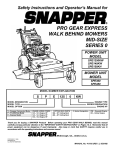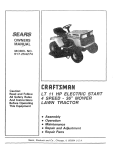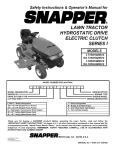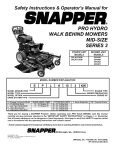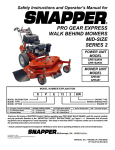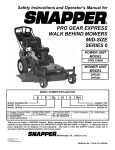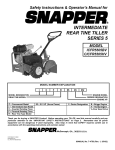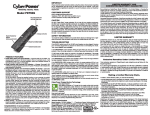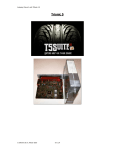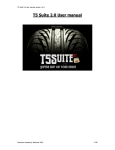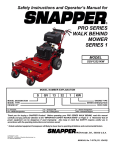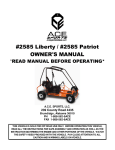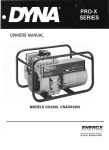Download Snapper SPE1250KW Lawn Mower User Manual
Transcript
Safety Instructions
and Operator's
Manual for
PRO GEAR EXPRESS
WALK BEHIND MOWERS
MID-SIZE
SERIES 0
POWER UNIT
MODEL
SPE1250KW
SPE140KW
SPE150KH
MOWER UNIT
MODEL
SPE361
SPE481
MODEL
t
NUMBER
P
E
EXPLANATION
125
MODEL DESIGNATION
MODEL TYPE
MODEL OPTION
S - Snapper Commercial
P - Pro Mid Size Model
E - Express Model
Model
ENGINE HORSE POWER
CUTTING DECK WIDTH
125-
12.5 Engine HP
361 - 36" Cutting Deck
140150-
14.0 Engine HP
15.0 Engine HP
481 -48"
0
I
KW
ENGINE TYPE
SERIES DESIGNATION
ENGINE HP
0- Series Designation
KW - Kawasaki Engine
KH - Kohler Engine
Cutting Deck
Thank you for buying a SNAPPER Product! Before operating your PRO GEAR WALK BEHIND, read this manual
carefully and pay particular attention to the "IMPORTANT SAFETY INSTRUCTIONS" on Pages 2 - 4. Remember that all
power equipment can be dangerous if used improperly. Also keep in mind that SAFETY requires careful use in
accordance with the operating instructions and common sense!
SNAPPERMcDonough,
GA,, 30253
U.S.A.
COPYRIGHT © 2000
SNAPPER INC
ALL RIGHTS RESERVED
MANUAL No. 7-3683 (I.R. 5/15/00)
IMPORTANT
SAFETY INSTRUCTIONS
WARNING: This powerful cutting machine is capable of amputating hands and feet and can throw objects that
can cause injury and damage! Failure to comply with the following SAFETY instructions could result in serious
injury or death to the operator or other persons. The owner of the machine must understand these instructions
and must allow only persons who understand these instructions to operate machine. Each person operating the
machine must be of sound mind and body and must not be under the influence of any substance, which might
impair vision, dexterity or judgment. If you have any questions pertaining to your machine which your dealer
cannot answer to your satisfaction, call or write the Customer Service Department at SNAPPER, McDonough,
Georgia 30253. Phone: (1-800-935-2967).
PROTECTION
FOR
CHILDREN
Tragic accidents can occur if the operator is not alert
to the presence of children. Children are often
attracted to the machine and the mowing activity.
Never assume that children will remain where you last
saw them.
1.
2.
3.
4.
5.
6.
7.
KEEP children out of the mowing area and under
the watchful care of a responsible adult.
DO NOT allow children in yard when machine is
operated (even with the blades OFF).
DO NOT allow children or others to ride on
machine or on attachments (even with the blades
OFF). They may fall and be seriously injured.
DO NOT allow pre-teenage children to operate or
service the machine.
Local regulations
may
restrict the age of the operator.
ALLOW only adults or responsible teenagers with
mature judgment under close adult supervision to
operate machine.
DO NOT operate blades in reverse. STOP BLADES.
LOOK and SEE behind and down for children, pets
and hazards before and while backing.
USE EXTRA CARE when approaching
blind
corners, shrubs, trees, or other objects that may
obscure vision.
PREPARATION
1.
Read, understand and follow
instructions and
warnings in this manual and on the machine,
engine, and attachments. Know the controls and
the proper use of the machine before starting. If
the operators or mechanics cannot read English, it is
the owner's responsibility to explain this material to
them.
2.
Only mature, responsible persons shall operate
the machine and only after proper instruction. The
owner is responsible for training the operators.
Further, the owner/operator can prevent and/or is
responsible for accidents or injuries occurring to
themselves, other people or property.
Data indicates that operators age 60 and above,
are involved in a large percentage of mowerrelated injuries. These operators should evaluate
their ability to operate the mower safely enough to
protect themselves and others from serious injury.
Handle fuel with extra care. Fuels are flammable
and vapors are explosive. Use only an approved
fuel container. DO NOT remove fuel cap or add
fuel with engine running. Add fuel outdoors only
with engine stopped and cool. Clean spilled fuel
from machine. DO NOT smoke.
3.
4.
5.
SLOPE
1.
2.
3.
4.
5.
6.
OPERATION
Slopes are a major factor related to slip and fall
accidents, which can result in severe injury. All
slopes require extra caution and slow speed. If
you feel uneasy on a slope, DO NOT mow it.
Mow across slopes, never up and down. Exercise
extreme CAUTION when changing directions on
slopes. Practice operation of machine on slopes
with blades off.
Use extra care with grass catchers or other
attachments: these affect the handling and the
stability of the machine.
DO NOT use tow behind attachments on slopes.
AVOID uphill starts.
Turf conditions can affect the machine's stability.
DO NOT operate machine under any condition
where traction, steering or stability is doubtful.
6.
7.
Practice operation of machine with BLADES OFF
to learn controls and develop skills.
Check the area to be mowed and remove all
objects such as toys, wire, rocks, limbs and other
objects that could cause injury if thrown by blade
or interfere with mowing.
Evaluate the terrain to determine what accessories
and attachments are needed to properly and safely
perform the job. Only use accessories
and
attachments approved by SNAPPER
8. Keep people and pets out of mowing area.
Immediately, STOP blades, STOP engine, and Stop
machine if anyone enters the area.
9. DO NOT operate machine unless all shields,
deflectors, switches, blade controls and other
safety devices are in place and functioning
properly.
10. Make sure all safety decals are clearly legible.
Replace if damaged.
A
IMPORTANT
SAFETY INSTRUCTIONS
A
PREPARATION
OPERATION
(Continued From Previous Page)
11. Protect
yourself
when
mowing
and
wear
appropriate clothing including safety glasses, long
pants, ear protection, hardhat and substantial
footwear
with good traction. Long hair, loose
clothing or jewelry may get tangled in moving
parts.
12. Know how to STOP blades and engine quickly in
preparation for emergencies.
13. Use extra care when loading or unloading the
machine into a trailer or truck.
14. Check grass catcher components frequently for
signs of wear or deterioration and replace as
needed to prevent
injury from thrown objects
going through weak or worn spots.
(Continued From Previous Column)
12. Before cleaning, repairing, or inspecting make
certain blades, engine and all moving parts have
STOPPED. Remove key and secure spark plug
wire away from spark plug key to prevent
accidental starting.
13. STOP MACHINE on level ground, engage parking
brake (if equipped) and make sure engine and
blades have stopped before leaving the operator's
position for any reason including removing grass
catcher or unclogging mower to prevent injury to
hands or feet.
14. Blades must be OFF except when cutting grass.
Set blades in highest position when mowing over
rough ground.
15. Keep hands and feet away from rotating blades
underneath deck.
OPERATION
1.
2.
3.
4.
5.
6.
16. DO NOT operate machine without entire grass
catcher or guards in place. DO NOT point
discharge at people, passing cars, windows or
doors.
17. Slow down before turning.
18. Watch out for traffic when near or crossing
roadways.
19. Move motion control levers SLOWLY to maintain
DO NOT put hands or feet near or under rotating
parts. Keep clear of the discharge area while the
engine is running.
BEFORE STARTING ENGINE, blades must be OFF
and Traction Levers LOCKED in the Traction Lock
position.
Stop Blades when crossing gravel drive, walks,
and under any conditions where thrown objects
might be a hazard.
DO NOT raise deck with the blades running.
Mow only in daylight or good artificial light.
USE EXTRA CARE when approaching
blind
corners, shrubs, trees or other objects that may
obscure vision.
control during speed and directional changes.
20. DO NOT operate engine in enclosed areas. Engine
exhaust gases contain carbon monoxide, a deadly
poison.
MAINTENANCE
7.
DO NOT operate the machine while under the
influence of alcohol or drugs.
8. After striking a foreign object or if the mower
vibrates abnormally, STOP the blades and engine.
Remove the key. Disconnect and secure the spark
plug wire. Inspect the mower for any damage and
repair the damage.
9. DO NOT operate machine near drop offs, ditches,
embankments,
washouts culverts, fences
and
protruding objects. STAY ALERT for holes and
other hidden hazards. Tall grass can hide
obstacles.
10. DO NOT operate machine on wet grass. Always be
sure of your footing while operating machine,
especially while backing up. Keep a firm grip on
the handle. Walk: never run. Slipping and falling
could cause injury.
11. DO NOT leave the machine with the engine
running. STOP BLADES, STOP ENGINE and
REMOVE KEY before leaving the operator position
for any reason.
1.
2.
3.
4.
5.
6.
3
Shut off fuel while storing or transporting. DO
NOT store machine or fuel container inside where
fumes may reach an open flame, spark or pilot
light such as in a water heater, furnace, clothes
dryer or other gas appliance. Allow engine to cool
before storing machine in an enclosure. Store fuel
container out of the reach of children in a well
ventilated, unoccupied building.
Clean grass and debris from engine, mufflers,
drives and cutting units to help prevent fires.
Clean up fuel, oil and excess grease.
When draining fuel tank, drain fuel into an
approved container outdoors and away from open
flame.
Check brakes frequently
(if equipped); adjust,
repair or replace as needed.
Keep all bolts, nuts and screws properly tight.
Check that all cotter pins are in proper position.
Always provide adequate ventilation when running
engine. Exhaust gases contain carbon monoxide,
an odorless and deadly poison.
A
IMPORTANT
SAFETY INSTRUCTIONS
MAINTENANCE
(Continued From Previous Page)
7. Disconnect
battery
before
performing
maintenance or service. Cranking engine could
cause injury. Disconnect negative (black) cable
from
battery
first
and
positive
(red)
last.
Reconnect positive first and negative last. Charge
battery in an open well ventilated area, free from
spark
and
flames.
Unplug
charger
before
connecting or disconnecting from battery. Wear
protective clothing and insulated gloves.
8. Park machine on level ground. DO NOT work
under machine without safety blocks.
9. Service engine and clean, adjust or repair only
when engine and blades are stopped. Remove key.
Remove spark plug wire(s) from spark plug(s) and
secure wire(s) away from spark plug(s).
10. DO NOT change engine governor speed settings
or overspeed engine. DO NOT make adjustments
with the engine running.
11. Lubricate machine at intervals specified in manual
to prevent controls from binding.
12. Mower blades are sharp and can cut, Wrap the
blades or wear heavy leather gloves and use
CAUTION when handling them. DO NOT straighten
or weld blades, only replace them.
13. DO NOT test for spark by grounding spark plug
next to spark plug hole; spark plug could ignite
gas exiting engine.
14. Carefully release pressure from components with
stored energy.
15. Have
machine
serviced
by an authorized
SNAPPER dealer at least once a year and have the
dealer install any new safety devices. DO NOT
allow untrained personnel to service the machine.
16. Use only genuine SNAPPER replacement parts to
assure that original standards are maintained.
4
A
TABLE OF CONTENTS
IMPORTANT SAFETY INSTRUCTIONS ...................................................................................
2-4
TABLE OF CONTENTS ................................................................................................................
5
SECTION 1 - FAMILIARIZATION
.................................................................................................
6
SECTION 2 - SAFETY MESSAGES&SYMBOLS
...................................................................
Controls .................................................................................................................
7-8
9
SECTION 3 -OPERATING INSTRUCTIONS ........................................................................
Before Operating ..........................................................................................................
Stopping Machine ........................................................................................................
Pre-Start Checklist .......................................................................................................
10-16
10
10
11
Starting and Operating ...........................................................................................
11-13
Reverse Operation ........................................................................................................
13
Traction Lock Operation ..............................................................................................
14
Turning Mower ..............................................................................................................
14
Mowing and Turning on Hillsides ...............................................................................
14
Cutting Height Adjustment (Fixed Decks) .................................................................
15
Adjusting Caster Wheels .............................................................................................
15
Adjusting Blade on Cutter Spindle ........................................................................
15-16
Adjusting Fixed Deck Attachment ..............................................................................
16
SECTION 4 - TROUBLESHOOTING
.....................................................................................
17-18
Engine Troubleshooting ..............................................................................................
17
Mower Troubleshooting .........................................................................................
17-18
Transmission Troubleshooting ...................................................................................
18
Service & Lubrication ...................................................................................................
18
SECTION 5 - ADJUSTMENTS
..............................................................................................
19-20
Steering and Brakes .....................................................................................................
Traction Levers & Rods ...............................................................................................
19
19
Handle Height ...............................................................................................................
Transmission Shift Lever Adjustment ........................................................................
20
20
SECTION 6 - POWER UNIT SERVICE ......................................................................................
Replacement Parts .......................................................................................................
Transmission Parts & Service .....................................................................................
21
21
21
General Transmission Servicing ................................................................................
Transmission/Lube ......................................................................................................
21
21
SECTION 7 - MOWER ATTACHMENT SERVICE ................................................................
22-24
Transmission Belt Removal/Installation ....................................................................
22
Traction Belt Removal/Installation .............................................................................
22
Cutter Deck Belt Removal/Installation .......................................................................
22
Cutting Blade Service: Removal, Sharpening, Balancing & Replacement ............. 23
Mower Spindles (Field Serviceable Spindles) Bearing Replacement ..................... 24
ELECTRICAL .........................................................................................................................
WARRANTY ................................................................................................................................
PRIMARY MAINTENANCE ....................................................................................................
5
25-26
27
28-31
SECTION 1 - FAMILIARIZATION
TRANSMISSION
LEVER
TRACTION
OPERATOR'S
PRESENCE
CONTROL (OPC)
LOCK
KEY
SWITCH
SHIFT
OPERATOR'S
PRESENCE
CONTROL (OPC)
LH.
\
TRACTION
LEVER
SPEED
CONTROL
R.H. TRACTION
LEVER
STARTER ROPE
CAP
AIR FILTER
BELT
COVER
MUFFLER
COVER
RETAINING
KNOBS
DECK COVER
DECK
(36"SHOWN)
41D ...
DISCHARGE
DEFLECTOR
CASTER
WHEEL
ASSEMBLY
DECK HEIGHT
ADJUSTMENTSPACERS
FRONT TIRES
FIGURE 1.1
1.1 INTRODUCTION
1.2 NOMENCLATURE
This manual has been prepared for the operator's of the
SNAPPER PRO GEAR WALK BEHIND MOWER•
Its
purpose, aside from recommending standard operating
procedures and routine service requirements, is to promote
SAFETY through the use of accepted operating practices•
Read, Understand and Follow the IMPORTANT SAFETY
INSTRUCTIONS on Pages 2 thru 4 of this manual and All
SAFETY messages on the PRO GEAR WALK BEHIND
MOWER and its attachments before operating• SNAPPER
recommends returning the MACHINE to an authorized
SNAPPER dealer annually for inspection and addition of any
new devices which might upgrade the safety of the mower.
It is recommended that all operator's of this equipment
become
thoroughly
familiar
with
the
controls,
components, and operation of this machine before
operating. Specific details involving the engine are found
in the separate engine owner's manual.
Study these
manuals before operating and keep both handy for future
reference. For the nearest SNAPPER dealer in your
area, check the yellow pages under the heading LAWN
MOWERS.
For engine parts and service, look for the
engine manufacturer's
dealers under the heading,
ENGINES - gasoline.
6
SECTION 2 - SAFETY MESSAGES AND SYMBOLS
I
i
CHOKE
I
i
BLADES ENGAGED"ON"
BLADES DISENGAGED"OFF"
[E"G'NEI
IE"°'NE
]
"STOP ....
RUN"
I
LEFT TRACTION LEVER
SQUEEZE FOR LEFT TURN
RIGHT TRACTION LEVER
SQUEEZE FOR RIGHT TURN
DANGER! ROTATING BLADES
KEEP CHILDREN AND OTHERS
OUT OF THE MOWING AREA
DANGER!
7
ROTATING BLADES
SECTION 2 - SAFETY MESSAGES AND SYMBOLS
IMPORTANT SAFETY AND OPERATING INSTRUCTIONS
8
SECTION 2 - CONTROLS
BLADE CLUTCH
SWITCH
OPERATOR'S
PRESENCE
CONTROL
ENGINE SPEED
CONTROL
KEY SWITCH
SHOWN IN
"STOP" POSITION
(OPC)
TRANSMISSION
SHIFT LEVER
RIGHT HAND
TRACTION LEVER
TRACTION
LOCK
FIGURE 2.1
NOTE: TRACTION LOCK SHOWN IN THE
TRACTION LEVER "LOCKED" POSITION
avoid sudden
ITo
starting machine
and unexpected turning, both Traction Levers must be moved the same way when stopping or
_IL
WARNING
motion.
9
SECTION 3 - OPERATING
3.1
BEFORE
INSTRUCTIONS
OPERATING
Be thoroughly familiar with all controls and how to use
them before operating the machine. Know beforehand
how to STOP the Traction Wheel Drives, Mower Blades
and Engine in preparation for possible emergencies.
3.2
1.
2,
3.
4.
5.
6.
7.
STOPPING
When the Operator's Presence Control (OPC) is
released, the machine will continue to operate a few
feet. DO NOT use WARNING
this Operator's Presence Control
(OPC) to rout ne y stop the mach he.
MACHINE
To STOP forward or reverse motion, firmly squeeze
both Traction Levers towards the handle and hold.
Using your index fingers, pulI right and left Traction
Locks back until both Traction Levers lock in
Traction Locked position. See Figure 3.1.
Make sure that both Traction Locks are in the
Traction Locked position.
Release both Traction Levers slowly and with
caution.
Move Transmission Shift Lever to "Neutral".
Pull Blade Clutch Switch rearward to the OFF
position. See Figure 3.1.
Move Engine Speed Control Lever to SLOW (turtle)
position. See Figure 3.1.
STOP ENGINE by turning Key Switch to "Stop"
position. Remove key. See Figure 3.1.
ENGINE
SPEED
BLADE
RIGHT HAND
TRACTION
LEVER
CLUTCH
CONTROL
SWITCH
SHOWN IN OFF
POSITION
TRACTION LOCK
SHOWN IN TRACTION
LOCKED POSITION
FIGURE 3.1
10
I
SECTION 3 - OPERATING
3.3
PRE-START
CHECK
INSTRUCTIONS
LIST
3.
Make the following checks and perform the services as
required before each start-up:
1. If required, make cutting height adjustments. Refer
to Section "CUTTING HEIGHT ADJUSTMENT".
2, Check tires and add air as needed to bring pressure
to 25 psi in front and 12-15 psi in rear tires.
3. Check Guards, Deflector, and Belt Covers to make
sure all are in place and secure.
4. Check Condition of Cutter Deck Belt(s). If damaged, replace before operating machine. Refer to
Section "CUTTER DECK BELT REMOVAL".
5. Clean Interior and Exterior Surfaces of cutting deck
and clean Engine of any accumulation of dirt, grass,
oil, etc. Keep Engine air intake screens and cooling
fins clear at all times.
6.
7.
Place Transmission Shift Lever in
position. See Figure 3.3.
TRANSMISSION
SHIFT LEVER
Check Engine Oil and add oil as needed to bring
level up to (but not over) the FULL mark. (Refer to
Engine manual for oil specifications).
Add Fuel to tank after pushing the Mower outside
where fumes can be dissipated. Make sure Fuel
Tank Cap is tightened after refueling.
(Refer to
Engine manual for fuel specifications).
NOTE: DO NOT add fuel while engine is running or hot.
Use fresh, clean, lead-free gasoline. DO NOT use
gasoline that has been stored for long periods. Leaded
gasoline or gasohot is NOT recommended.
FIGURE 3.3
4.
Pull Blade Clutch
position.
Switch
rearward
See Figure 3.4.
3.4 STARTING
& OPERATING
3.4.1. ENGINE: START ENGINE AS FOLLOWS:
1,
2,
NEUTRAL(N)
Turn Fuel Shut-OffValve ON. See Figure 3.2.
Squeeze both Traction Levers toward the Handle
while pulling right and left Traction Locks rearward
until BOTH Traction Levers are LOCKED in the
Traction Locked position. See Figure 3.2.
BLADE CLUTCH
SWITCH SHOWN
IN OFF
RIGHT HAND
TRACTION
LEVER
TRACTION LOCK
SHOWN IN TRACTION
LOCKED POSITION
FUEL SHUT OFF
VALVE SHOWNIN
CLOSED POSITION
(ROTATE HANDLE 90
DEGREES TO OPEN)
FIGURE 3.4
FIGURE 3.2
(Continued on next page)
11
to the OFF
SECTION 3 - OPERATING
3,4
5.
6.
STARTING
& OPERATING
INSTRUCTIONS
-
9.
(Continued from previous page)
Move Engine Speed Control Lever to the CHOKE
position. See Figure 3.5.
Turn Key Switch to RUN position.
10.
Place Transmission Shift Lever in No. 1 position
(first gear). See Figure 3.3.
Push Blade Clutch Switch to ON position. See Figure
3.5.
NOTE: Releasing the Operator's Presence Control
(OPC) while Transmission is in GEAR and/or Blades
ON, will Ground the Ignition Circuit and cause the
Engine to STOP, allowing the Machine to travel only a
few feet before coming to a complete STOP.
MOVE ENGINESPEED
CONTROL TO CHOKE
I_LEFT
SIDE
, IL
\
_
SWITCH
11. To START MACHINE MOVEMENT, squeeze both
Traction
Levers firmly against the handlebar
allowing the right and left Traction Locks to move to
the "Unlocked" position. Using caution, slowly and
simultaneously allow both Traction Levers to move
forward. The machine wilI begin to move forward.
"OFF"
SHOWN
POSITION IN
FIGURE 3.5
IMPORTANT: DO NOT jerk the engine recoil starter
handle or allow it to snap back.
IMPORTANT: Always STOP machine movement and
engage both Traction Locks before changing to a
different
ground speed. Transmission
damage
could result if ground speed is changed when
machine is moving.
NOTE: Engine will not start unless the transmission is in
NEUTRAL position and Blade Clutch Switch is in OFF
position,
7.
8.
WARNING
Start mowing with a slow ground speed and I
gradually increase speed to determine the most I
comfortable travel speed.
I
Pull Engine Recoil Starter Handle until you hear the
first firing sound.
Move Engine Speed Control
Lever to the FAST (rabbit) position. Pull Recoil
Starter Handle and Engine should start.
Depress Operator's
Presence
Control (OPC)
against handle. See Figure 3.6.
WARNING
During initial training time with machine, it is
advised that the operator(s) practice all mower
movements while operating the mower with the
transmission shift lever in no. 1 (first gear) travel
speed position and blade clutch switch in off
position! DO NOT make sharp turns at high speeds!
12. The machine is TURNED by squeezing either the
left or right Traction Lever. Squeezing the control
declutches the drive belt and applies a brake. Turn
left by squeezing the left Traction Lever or turn
right by squeezing the right Traction Lever. See
Figure 1.1. The more pressure applied while
squeezing the Traction Lever, the sharper the
mower wilI turn.
CONTROL(OPC)
TRACTION LOCK
SHOWNIN
TRACTION
LOCKED POSITION
FIGURE 3.6
(Continued on next page)
12
SECTION 3 - OPERATING
3.4
STARTING
INSTRUCTIONS
& OPERATING
WARNING
(Continued from previous page)
13. STOPPING MACHINE,
Simultaneously
squeeze both Traction Levers
firmly against the handle and hold. Pull both the
right and left Traction Locks rearward with index
fingers until both Traction Levers are locked in the
Traction Locked position.
14.
Pull the Blade Clutch Switch rearward to the OFF
DO NOT operate blades in reverse. Stop blades.
LOOK and SEE behind and down for children, pets
and hazards before and while backing. Engine
speed must be set to SLOW before operating in
reverse.
3.5 REVERSE
OPERATION
3.5.1. TO REVERSE DIRECTION
1. To REVERSE DIRECTION OF MACHINE, STOP
Machine and lock Traction Levers.
2. Pull Blade Clutch Switch rearward to the OFF
position. Move Engine Speed Control Lever to slow
(turtle) position.
3. Move Transmission Shift Lever to REVERSE (R)
position.
4. Hold Operator's Presence Control (OPC) against
handlebar.
position. See Figure 3.7.
BLADE CLUTCH
SWITCH SHOWN
IN OFF POSITION
SWITCH
5.
To START MACHINE MOVEMENT, simultaneously
squeeze both Traction Levers firmly against the
handle allowing the right and left Traction Locks to
release.
6.
Using caution, simultaneously and slowly release both
Traction Levers. The machine will begin to move in
reverse.
To STOP forward or reverse motion, firmly squeeze
both Traction Levers towards the handle and hold.
Using your index fingers, pull right and left Traction
Locks back until both Traction Levers lock in
Traction Locked position. See Figure 3.8.
7.
FIGURE 3.7
15.
16.
17.
Place the Transmission
Shift Lever into the
NEUTRAL (N) position.
Move engine speed control to slow (Turtle)
position.
Stop engine. Turn key switch to "Stop" position.
Remove key. See Figure 2.1.
WARNING
1. SQUEEZE TRACTION LEVERS
2. PULL TRACTION LOCKS
REARWARD TO LOCK
\
AI
DO NOT leave machine with engine running. Stop
engine. Stop blades. Lock Traction Levers. Removel
key. DO NOT park machine on slopes.
I
TRACTION LOCK
TRACTION LEVER
(RIGHT HAND - RELEASED
POSITION SHOWN)
FIGURE 3.8
13
SECTION 3 - OPERATING
INSTRUCTIONS
WARNING
Brakes require maintenance.
operation
before
operating
Section
"ADJUSTMENTS,
BRAKES".
3.6 TRACTION
3.6.1 TO LOCK
LOCK
&l
WARNING
Inspect for proper
machine.
Refer to
STEERING
AND
OPERATION
Machine should always be in forward motion before I
attempting a turn. DO NOT attempt a turn from a[
stopped position.
I
3.7 TURNING
MOWER
3.7.1. GRADUAL RIGHT & LEFT HAND TURN
-
1.
Simultaneously
squeeze both Traction Levers
toward the handte, to stop movement of machine.
2, Using index fingers pulI right and Ieft Traction Locks
rearward until both Traction Levers are locked in the
Traction Locked position.
3.6.2 TO UNLOCK
1. Simultaneously squeeze both Traction Levers firmly
against the handle. The right and ieft Traction Locks
will move to the "Unlocked" position. See Figure 3.9.
IMPORTANT! Always make sure that both right and
left Traction Locks are in the same position before
moving or releasing the Traction Levers.
IMPORTANT: Squeezing the right or left traction lever
applies the brake to the right or left wheel. The brake
turns the machine right or left.
RIGHT TURN:
1.
With machine in motion gradually squeeze the right
hand Traction Lever. The machine will turn to the right.
LEFT TURN:
2,
With machine in motion gradually squeeze the left
hand Traction Lever. The machine will turn to the left.
TRACTION
LEVER
POSITION
LEFT HAND
\
BRAKE POSITION
TRACTION LEVER
(LEFT HAND)
DRIVE POSITION
TRACTION LOCK LEVER
FIGURE 3.10
TRACTION
LEVER
3.8 MOWING
(RIGHT HAND - RELEASED
POSITION SHOWN)
AND TURNING
ON
HILLSIDES
1.
FIGURE 3.9
Always mow hillsides starting at bottom of hill. Mow
across slopes, never up and down.
Exercise
caution when changing directions on slopes. DO
NOT mow steep slopes!
IJ IL
WARNING
AI
DO NOT mow on steep slopes. DO NOT use with I
any type rider attachment on slopes. DO NOT park [
machine on slopes.
I
2,
3.
14
Hillside mowing is accomplished
by squeezing
Traction Lever on the UPHILL SIDE of machine.
This helps reduce side slipping of mower.
When turning mower on hillsides, always turn
toward the UPHILL SIDE
of mower for better
control and balance.
SECTION 3 - OPERATING
3.9
CUTTING
HEIGHT
INSTRUCTIONS
3.11
ADJUSTMENT
ADJUSTING BLADE ON CUTTER
SPINDLE
(Fixed Decks)
Mower has three methods of adjusting cutting height:
1. Moving position of BLADE on cutter spindle shaft.
2. Moving position of CASTER WHEEL on support.
3. Moving position of MOWER DECK on power unit.
To change cutting height of Blades, move the Spacers from
under the Cutter Housing to above the Cutter Housing
Pulley. Each Spacer moved above the Cutter Housing
Pulley will provide an additional 1/4" of cutting height. DO
NOT put any Spacers below Blade. See Figures 3.13 and
3.14.
WARNING
DO NOT attempt any maintenance, adjustments or
service with the engine running. Stop engine. Stop
blades.
Lock
Traction
Levers.
Remove
key.
Disconnect spark plug wires from spark plugs and
secure wires away from spark plugs. Engine and
components are HOT. Avoid serious burns, allow all
parts to cool before working on machine.
3.10.
ADJUSTING
CASTER
WHEELS
The Caster Wheel Assembly has four (4) 1/2" and one
(1) 1/4" thick spacer. The 1/4" thick spacer always stays
on the stop side of the caster support tube. The 1/2"
thick spacers are used to adjust the cutting height. When
placed above or below Caster Support Tube, they raise
or lower cutting height in 1/2" increments, thus providing
a "Quick-Adjust" method. The deck mounting has to be
changed to correspond to the caster repositioning. Refer
to Section "ADJUSTING FIXED DECK ATTACHMENT".
1.
FLAT//
\
FIGURE 3.12
Remove Retainer Pin from Caster Shaft. See Figure
3.11.
AIR LIFT
HEIGHT
ADJUSTING
SPACERS
CASTER
SUPPORT
CASTER
SHAFT
BEVEL
BLADE
TIGHTEN TO 60-75 FOOT POUNDS
FIGURE
PIN
NOTE: Changing cutting height of
change the deck ground clearance.
cutting pattern results, then cutting
must be made by adjusting mower
caster wheels.
FIGURE 3.11
2.
3.13
Lift Caster Support while adding or removing bottom
spacer. See Figure 3.12.
blades does not
If an undesirable
height adjustment
deck height and
Install Blades (Air Lift Up) with retaining hardware as
shown below and tighten to 60 to 75 ft.-Ibs. See Figure 3.14.
NOTE: Remove (or add) spacers by rotating slots to
align with flat area on caster shaft.
(Continued on Next Page)
15
SECTION 3 - OPERATING
3.11
INSTRUCTIONS
ADJUSTING BLADE ON CUTTER
SPINDLE (Continued)
SPACERS
CUTTER
SPACERS
HOUSING
PULLEY
t!l_
_
ON TOP
_......--,
._...
,....,,,.,,,,,,....._
CUTTER
I
r"
BLAO
l f
_1
HOUSING
FIGURE 3.15C: MIDDLE HIGH CUT 3" TO 4"
BOTTOM
SPACERS
ON
u_
SPACERS
FIGURE 3.14
3.12
ADJUSTING
FIXED
DECK
ATTACHMENT
The mower deck has four different positions for attaching
it to the power unit. The lowest setting provides a cutting
height range of 1-1/2" to 2-1/2", the middle low cut is 21/4" to 3-1/4", the middle high cut is 3" to 4", and highest
cut is 3-3/4" to 4-3/4". Make sure the spacers on the
caster wheels are moved up or down as shown to
correspond with the bolt )ositions to keep deck level.
Once a desired cutting height is reached, attach the
mower deck to the power unit by installing 3 bolts on
each side in selected height of cut holes. Tighten bolts to
70 to 80 foot pounds torque. See Illustration.
FIGURE 3.15D: HIGH CUT 3-3/4" TO 4-3/4"
FIGURES 3.15C-D
SIDE PROFILE OF UNIT
BLACK DOTS
REPRESENT
BOLT ANCHOR
HOLES
POWER
UNIT _
•
REAR
FIGURE 3,15A: LOW CUT 1-1/2" TO 2-1/2"
FIGURE 3.15B: MIDDLE LOW CUT 2-1/4" TO 3-1/4"
FIGURES 3.15A-B
16
SECTION 4 - TROUBLESHOOTING
ENGINE
TROUBLESHOOTING
SYMPTOM
PROBLEM
Engine ...................
does not ................
stare ......................
...............................
...............................
Key OFF. ..............................................................................................
.Turn Key to Run.
Fuel Tank empty. ..................................................................................
Fill Fuel Tank.
Fuel Shut-Off Closed. ...........................................................................
.Open Fuel Shut-Off.
Engine Throttle Control not at FAST (Rabbit) position .......................... Put Engine Throttle Control to FAST
Choke NOT closed ................................................................................
Put Throttle Control in CHOKE position.
Check choke adjustment.
Spark Plug Wire loose or disconnected. ...............................................
Connect Spark Plug Wire.
Operator Presence Control (OPC) Switch out of adjustment ............... .Adjust Switch
Blade Clutch Switch in ON position. .....................................................
.Pull Blade Clutch Lever to OFF position.
Spark Plug bad ......................................................................................
Install new Spark Plug.
Dirty Air Filter .......................................................................................
.Clean Air Filter.
Transmission not in NEUTRAL .............................................................
Shift Transmission Lever to NEUTRAL.
...............................
...............................
...............................
...............................
...............................
...............................
Engine ...................
Starts Hard
or Loses ................
Power. ...................
..............................
...............................
SOLUTION
Dirt or water Fuel Tank. ........................................................................
Vent in Gas Cap plugged. ....................................................................
Air Filter dirty. ........................................................................................
Spark Plug not gapped correctly. ..........................................................
Spark Plug bad .....................................................................................
Drain and clean Fuel Tank. Fill with
fresh Fuel.
,Clean Vent or install new Gas Cap.
Clean or install new Air Filter.
Check and set Spark Plug gap.
Install new Spark Plug,
Engine .................. Spark Plug ba& .....................................................................................
Runs ...................... Spark Plug not gapped correctly. ..........................................................
Erratically. ............. Fuel Filter plugged or dirty. ...................................................................
Install new Spark Plug.
Clean and set Spark Plug gap.
Replace Fuel Filter.
Engine .................. Dirty Air Filter .......................................................................................
Idles PooHy. .......... Fuel Filter plugged ................................................................................
.Clean or replace Filter.
Replace Fuel Filter.
Engine .................. Engine Oil tow in Crankcase ................................................................
Overheats. ............. Engine Cooling Fins clogged ...............................................................
.Add OiL
Clean Engine Cooling Fins.
Machine ................
Vibrates .................
Excessive. .............
...............................
.Tighten
Sharpen
.Tighten
Replace
Blade Mounting Bolts loose. .................................................................
Blade out of Balance. ............................................................................
Engine Mounting Bolts loose. ...............................................................
Damaged or Severed Belt .....................................................................
Engine ................... Mowing grass too tall ...........................................................................
Dies. ....................... Mowing too fast. ....................................................................................
MOWER
Blade Mounting Bolts.
and balance Blade.
Mounting Bolts.
Belt
.Adjust cutting height.
Reduce travel speed.
TROUBLESHOOTING
SYMPTOM
PROBLEM
Mower does ............. Transmission in neatraJ ....................................................................
SOLUTION
.Select Gear
not move .................. Traction Control Rod adjustment. .....................................................
.Adjust Rod
when Traction .......... Engine to Transmission Belt Damaged or Broken ............................. Replace Belt
Levers released ....... tdter Spring Damage or Broken .........................................................
Replace Spring
Mower does ............. Slipping or broken Traction Belt .......................................................
riot track ................... Tire pressure in both Traction Wheels .............................................
straight. .................... not the same.
.Adjust or replace Belt.
.Adjust air pressure.
Blades DO ................ Belt slipping or broken. ......................................................................
NOT engage. ............ Clutch does not engage ....................................................................
Replace or adjust Belt.
.Check Electrical Connections
Mower .......................
mows ........................
unevenly. ..................
..................................
......................................
..................................
..................................
Travel speed too fast. ........................................................................
Operator making mower turn corner too fast. ..................................
Rough terrain. ....................................................................................
Unequal number of Blade Spacers on
Cutter Shafts or Caster Wheels. ....................................................
Low Or No Air Pressure in Tires ........................................................
Dull Blades ........................................................................................
17
& Clutch
Reduce ground speed.
Reduce ground speed.
Change mowing pattern.
Install equal number of Spacers.
Fill Tires with Correct Air Pressure
Sharpen Blades or Install new Blades
SECTION 4 - TROUBLESHOOTING
MOWER
TROUBLESHOOTING
(Continued)
SYMPTOM
PROBLEM
SOLUTION
Mower not ......................................
cutting full ......................................
width.
Broken or slipping Blade Belt .......................................
Dull, Damaged or Worn Blades ...................................
Replace Belt.
Sharpen Blades or Install new Blades
Discharge .......................................
Deflector Becomes ........................
Obstructed .....................................
Grass wet. ....................................................................
Mower too low..............................................................
Engine overloaded .......................................................
Let Grass dry.
Raise cutting height
Run Engine at full Throttle and reduce
travel speed.
TRANSMISSION
TROUBLESHOOTING
SYMPTOM
PROBLEM
SOLUTION
Unit is ............................................
Noisy. ..............................................
........................................................
........................................................
Gearing is overly noisy - chatter, etc. ...........................
Worn Gears.
Worn Bearings - mainly input Shaft
Ball Bearing.
Return to Authorized Snapper Dealer
Unit Jumps ....................................
Out of Gear. ....................................
Teeth of Gears are worn beyond tolerances.
Spring in Shifter Fork weak or broken.
SERVICE
& LUBRICATION
HOURS
PROCEDURE
COMMENTS
BREAK4N .......................................
........................................................
........................................................
Check all Grease Points and add if necessary
Check alt Fasteners for proper tightness.
Change Engine Oil and Filter at 5 hours. ..................... (See Engine Manual)
DAILY. .............................................
Check Engine Oil .........................................................
........................................................
Clean Air Filter. ............................................................
........................................................
Clean Air Intake Screen. .............................................
........................................................
Remove Debris from under Belt Cover. .......................
........................................................
Sharpen Cutter Blades. ................................................
........................................................
Grease Cutter Spindle Bearings. .................................
.............................................................................................................................................
........................................................
Inspect Interlock Switches for Damage ........................
........................................................
Inspect Belts for Wear or Damage ...............................
........................................................
Inspect brakes. ............................................................
Change Oil if extreme dusty conditions.
More often if needed.
More often if needed.
More often if needed.
Tighten to 60-75 Ft.-Lbs.
Use Chevron SRt Grease or equal.
(NLGI No. 2)
Replace if Needed.
Replace if Neede&
.Adjust for proper steering / stopping.
WEEKLY ........................................
........................................................
........................................................
........................................................
........................................................
........................................................
........................................................
........................................................
........................................................
........................................................
........................................................
........................................................
.Add or Adjust as required.
Inspect OPC Switch for proper Operation.
.One Shot General Purpose Grease.
Replace if Worn.
More often if needed.
More often if needed.
.General Purpose Grease.
.General Purpose Grease.
.General Purpose Grease.
.General Purpose Grease.
Replace with SNAPPER P.N. 1-4359
MONTHLY. ......................................
........................................................
Check Tire Pressure. .................................................
Check Safety Interlock System ....................................
Lube Traction (Drive) Levers. .....................................
Inspect Traction Lock for Wear ....................................
Change Engine Oil and Filter .......................................
Replace Air Filter .........................................................
Grease Caster Wheel Bearings. .................................
Grease Caster Support Arms. .....................................
Grease Traction Wheels. ............................................
Grease Idler Arm Pivots on Cutter Deck. ....................
Fuel Filter .....................................................................
Grease Traction Idler Pulley (Located on the
Underside of Power Unit) ............................................
Clean and Adjust Spark Plugs. ....................................
Lube Controls and Unkages. .......................................
18
.General Purpose Grease.
(See Engine Manual)
Use Medium Duty Oit.
SECTION 5 - ADJUSTMENTS
5.1
Pull rearward hard on the Traction Levers. The
space used to lock the Traction Locks should not
bottom in the slot. Set the Traction Locks into the
STEERING/BRAKES
If machine is not as responsive as desired when either
Traction Lever is squeezed, one or both brakes should
be adjusted as follows:
1.
2.
3.
Locked position. The Idler Pulleys, Upper and
Lower should have completely declutched the belt.
Release the Traction Locks and adjust as required.
Operate mower on level terrain with Transmission
Shift Lever in No. 1 position.
Determine which
brake requires adjustment.
Stop engine, remove the key from switch and
disconnect spark plug wire from spark plug. Secure
wire away from plug.
Turn nut clockwise to increase brake tension. See
Figure 5.1.
4,
Remove the hairpins from the traction
rod
adjustment blocks and remove the adjustment
blocks from the traction links on each side of the
mower. See Figure 5.2.
ROTATE
ADJUSTMENT
1/16" TO 1/8'
GAP
'1
\"
(_
1
.._
tj
BLOCK
,__H
REMOVE
AIRPIN
BETWEEN
"iT-"TENSION
TORN
BRAKE ARM
FIGURE 5.2
5.
FIGURE 5.1
4,
6.
Place spark plug wire onto spark plug. Start engine
and operate mower with transmission in the No. 1
position to check for proper adjustment.
If further
adjustment is required, follow all steps above.
7.
8.
5.2 TRACTION
LEVERS/RODS
If the Traction Wheel Drive Belts become slack or new
belts have been installed, it will be necessary to adjust
the Traction Levers as follows:
1.
2.
3.
Rotate the adjustment block as required to make
the idler arms almost touch against the belt cover
studs when the Traction Levers are locked. There
should be about 1/16" to 1/8" gap between the idler
arms and studs. See Figure 5.2
Reinstall the adjustment blocks and the hairpins.
Check the settings as described above. Repeat as
necessary.
Reassemble the Brake Rods to the Brake Arms
with the hairpins removed earlier.
Replace the Spark Plug Wire onto the Spark Plug.
Start the mower according to the Safety Instructions
and operate it to check the adjustments.
NOTE: It may be necessary to adjust the Traction Brakes
after adjustment of the Traction Belts is complete.
Move the machine to a smooth, level surface and
turn the engine OFF. Release the traction locks.
Disconnect the Brake Rods from the Brake Arms.
See Figure 5.1
Remove the key from the switch, remove the spark
plug wire from the spark plug and secure it away
from the plug.
Shift the transmission to No. 1 position.
Iuo.NOTdo attempt WARNING
to operate machine
without
studs secured into the proper position,
19
belt I
I
SECTION 5 - ADJUSTMENTS
5.3 HANDLE
HEIGHT
The operator handle can
comfort as follows:
1.
2.
3.
4.
5.
6.
7.
5.4
be adjusted
for
operator
1.
Loosen the upper carriage bolt and nut on both sides
of handlebar. See Figure 5.4.
Remove lower carriage bolt and nut on both sides of
handlebar.
Raise or lower handlebar to desired height. See
Figure 5.3.
Install the carriage bolt and nut in the lower hole in
handlebar and securely tighten nut. See Figure 5.4.
Securely tighten the upper carriage bolt and nut.
After adjusting the handle height readjust traction
links as described earlier. Shift rod (Connects the
ground speed control lever and the transmission) will
have to be readjusted.
Readjust traction levers/rods when handle height is
changed.
*FACTORY SETTING
2,
3.
TRANSMISSION
ADJUSTMENT
SHIFT LEVER
Disconnect the hair pin from shift rod that connects
to the Transmission Shift lever. See Figure 5.5.
Move the Transmission Shift Lever to the neutral
position. Move the shift lever, located on the
transmission, to the neutral position.
Rotate the shift rod clockwise or counter clockwise to
allow the upper portion of shift rod to be inserted into
the ground speed control lever without moving the
speed control lever or the Transmission Shift lever.
Reinstall hair pin. See Figure 5.6.
TRANSMISSION
SHIFT
LEVER
U
't,
DISCONNECT
SHIFT ROD
FROM THIS
POINT
(3)%-
SHIFT ROD
(1) --,_.l
FIGURE 5.3
FIGURE 5.5
RAISE
LOOSEN
UPPER
CARRIAGE
BOLT
SHIFT
SHIFT
LOWER
REMOVE
LOWER
CARRIAGE
BOLT
FIGURE 5.4
FIGURE 5.6
20
SECTION 6 - POWER UNIT SERVICE
6,1
REPLACEMENT
6.2,2, TRANSMISSION
The Peerless MST 205 Series Transmission requires
no routine maintenance.
Return machine to an
authorized Snapper dealer for service, maintenance or
problems.
PARTS
To retain the quality of your mower, use Genuine
SNAPPER Replacement Parts only! Contact your local
SNAPPER dealer for parts and service assistance. For
the correct part or information for your mower, always
mention Model and Serial Number of Power Unit and
6.2,3.
Mower Attachment.
We recommend returning your
mower to an authorized SNAPPER Dealer on a yearly
basis for inspection and addition of any new devices
which might upgrade the performance and safety of
your mower. For the nearest SNAPPER Dealer, check
the Yellow Pages under the heading LAWN MOWERS.
For Engine Parts and Service, look for the Engine
Manufacturer's Dealers under the heading ENGINESGasoline. For transmission parts and service, Iook for
Tecumseh Engines & Transmission under EnginesGasoline.
2.
3.
WARNING
All
mid-size
mowers
should
be tilted with
engine carburetor side UP.
6,2 TRANSMISSION
PARTS & SERVICE
For the nearest Peerless Transmission Dealer, check
the Yellow Pages under heading, Engine-Gasoline.
Look for Tecumseh Engine and Transmission under
Engine-Gasoline.
6.2,1. GENERAL TRANSMISSION SERVICING
The following service procedures should be understood
and practiced whenever service must be performed on
a Peerless MST 205 Series Transmission.
1,
LUBE
The transmission is permanently sealed. But, lubrication
can be added if leakage should occur. The transmission
case holds 16 ounces of 80W-90 gear oil. To Lubricate:
1. Remove transmission switch wire plug and remove
the transmission interlock switch. Remove the fiber
washer seated on switch.
DO NOT attempt any maintenance, adjustments or
service with the engine running. Stop engine. Stop
blades.
Lock Traction
Levers.
Remove
key.
Disconnect spark plug wires from spark plugs and
secure wires away from spark plugs. Engine and
components are HOT. Avoid serious burns, allow all
parts to cool before working on machine.
NOTE:
TRANSMISSION
Before removing transmission from mower, make
sure another part of machine is not causing
problem, look for:
a) Loose drive belt.
b) Sheared keys in pulleys.
c) Oil saturated drive belts.
d) Transmission shift lever secure.
21
Transmission oil is added through the switch hole.
Install new fiber washer, part number 2-9662, onto
switch. Install switch into transmission and tighten
securely. Attach wire plug onto switch.
SECTION 7 - MOWER ATTACHMENT
7.1
TRANSMISSION
BELT
REMOVAL/REPLACEMENT
SERVICE
Adjust Traction Rod and Brake Rod as necessary.
Refer
to
Section
"ADJUSTMENTS
STEERING/BRAKES
and
TRACTION
LEVERS/RODS".
4,
WARNING
TRACTION
DO NOT attempt any maintenance, adjustments or
service with the engine running. Stop engine. Stop
blades.
Lock Traction
Levers.
Remove
key.
Disconnect spark plug wires from spark plugs and
secure wires away from spark plugs. Engine and
components are HOT. Avoid serious burns, allow
all parts to cool before working on machine.
1.
2,
Disconnect idler arm spring.
Remove existing belt. Replace with new belt, part
no. 2-9118.
3.
Reconnect idler arm spring. See Figure 7.1.
BELT
OUTPUT PULLEY
TRANSMISSION
IDLER BELT
(WHEEL
PULLEY
NOT
SHOWN)
/
BELT COVER
FIGURE
7,3
1.
CUTTER
DECK
WING NUT
7.2
BELT REMOVAL
2,
Remove idler spring and swing idler away from belt.
See Figure 7.3.
3. Remove old belt from spindle pulleys and electric
clutch pulley.
4. Route new belt, part number 3-5710 for 36" Deck &
2-9261 for 48" Deck around spindle pulleys.
NOTE: 36" Deck Belt also connects to electric clutch.
5. Move idler to belt and re-attach tension spring.
6. For 48" Deck to electric clutch use belt 2-9262.
IDLER ARM
SPRING
ELECTRIC
CLUTCH
o
FIGURE 7.1
7,2
TRACTION
BELT REMOVAL
36" DECK SHOWN
&
REPLACEMENT
7.2,1. TRACTION BELT REMOVAL
1.
2.
3.
IDLER
TRACTION BELT INSTALLATION
1.
STOP ENGINE!
number 4-6240, flat
Wheel. Roll Traction
wheel is in middle of
2,
Place Traction Belt on Wheel Pulley followed by
Transmission Output Pulley.
Reinstall belt cover and tighten two wing-nuts.
3.
REMOVE
BELT
STOP ENGINE! Remove two wing-nuts retaining
belt cover. Remove belt cover. See Figure 7.2.
Remove Traction Belt from Wheel Pulley first by
running Belt off as Wheel is turned. Remove belt
from Transmission output Pulley next.
Lay Traction Belt flat on ground (around tire) and roll
Mower Wheel over Traction Belt, removing Traction
Belt from machine,
7.2,2,
&
INSTALLATION
Remove mower deck belt cover.
Lay new Traction Belt, part
on ground in front of Traction
Wheel over Traction Belt until
belt.
FIGURE 7.3
22
SECTION 7 - MOWER ATTACHMENT
7.4
CUTTING
BLADE
SERVICE
SERVICE
WARNING
Check blades after each use for signs of excessive
wear and damage. See Figure 7.4 for blade wear limits.
"
Blades are extremely sharp and can cause severe
injury. Wear heavy leather gloves when handling or
working around blades. DO NOT use a blade that is
excessively worn or damaged.
NEW BLADE"
HEAVY
END OF
BLADE
22 ° TO 28°
BLADE
_'_t_
WEAR LIMIT
_._._
_
_
(NOTCH
STARTS)
1/64"
DANGEROUS CONDITION!
DO NOT USE ON MOWER!
REPLACE WITH NEW BLADE.
ORIGINAL
CUTTING
EDGE
FIGURE 7.5
FIGURE 7.4
1.
NOTE:
When
sharpening
Blades,
leave
1/64"
untouched. Razor sharp Blades dull quicker and
damage easier. Commercial balancers are available
and should
be used in accordance
with the
manufacturers instructions.
Use the following chart for ordering replacement
Blades for the 36" & 48" Mowing Decks.
STANDARD REPLACEMENT
BLADES
8.
I
7.4.1.
1.
2.
36"DECK
2-9246
t
48"DECK
2-9247
Install Blade Mounting Bolt with spacers and Blade
into spindle.
9. Install an equat amount of Blade Spacers onto each
blade mounting bolt.
10. Install the Blade Mounting Nut on each Blade
Mounting Bolt. See Figure 7.6.
11. Torque each Blade Mounting Bolt and Nut to 60 to
75 ft. Ibs of torque.
I
BLADE REMOVAL AND SHARPENING
Place the mower on a smooth level surface, turn
engine OFF, remove key, disconnect Spark Plug Wire
from Spark Plug and secure Wire away from Plug.
Remove blades.
AIR LIFT
IMPORTANT: Note the number of blade spacers that
are under the Blade Mounting Nuts and on the Spindle
side of the Blade.
3.
4.
5.
6.
7.
BLADE
SPACERS
Clean and inspect each Blade for excessive wear and
damage. Refer to Section "BLADE WEAR LIMITS".
Refer to the STANDARD REPLACEMENT BLADE
chart above for correct SNAPPER Replacement Blades.
Should Blades be in acceptable condition, sharpen at
22 to 28 degrees. DO NOT sharpen beyond original
cutting edge. See Figure 7.5.
Balance each Blade after sharpening by grinding
metal from the heavy end of the Blade.
Place the Blade mounting bolt through bevel washer
and into Blade and place Blade Spacers over Bolt.
Make certain each Blade is installed with the same
amount of Spacers between blade and spindle.
BLADE
MOUNTING
BOLT
BLADE
TIGHTEN TO 60-75 FOOT POUNDS
FIGURE
23
7.6
SECTION 7 - MOWER ATTACHMENT
7.5
MOWER
SPINDLES
(Field
Serviceable
Spindles) BEARING REPLACEMENT
In the event that a spindle
bearing
requires
replacement, the SNAPPER Field Serviceable Spindles
have been designed so that no special tools or presses
are required.
1. Remove belt. Loosen blade nut and remove. Allow
blade bolt, washer, blade and four spacers to drop
down out of the spindle housing.
See Figure 7.7.
5.
6.
7.
0 / REMOVE BELT
FIGURE 7.7
÷
PULLEY
RING
HOUSING
INNER RACE "_O{_
¢
Insert spindle shaft up through the bottom bearing.
Slide spacer down over spindle shaft.
Install new top bearing. Install the top bearing with
the seal/shield UP.
13. Pump grease into spindle housing until grease
purges from vent on housing.
14. After the first 5 hours of operation, grease spindle
housing to insure it is full, then every 25 hours.
Remove spindle pulley from spindle shaft.
Locate circular retaining ring on spindle shaft at top
bearing. Remove retaining ring. Allow spindle shaft
to drop out of housing.
Top and bottom bearings are now removable. Pull
out on inner race to slide bearing from housing.
See Figure 7.8.
BEARING "_O
old
IMPORTANT: Spindle housing must be filled with
grease before operating mower. Failure to fill
housing will cause premature bearing failure.
i "--;g TOVE
BLABE
BEARING
SEAL UP
all
Slide circular retaining ring down spindle shaft until
it fully locks into groove on shaft.
10. Place spindle pulley and spacer on top of spindle
shaft.
11. Reinstall blade bolt, washer, blade and four
spacers.
12. Torque blade bolt and nut to 60 to 75 ft. Ibs.
f
J
4.
removing
9.
FROM SPINDLE
2.
3.
Thoroughly
clean all parts
contaminated grease.
Install new bottom bearing first.
NOTE: The bearing is sealedlshielded on one side only.
The bottom bearing must be installed with the
seated/shielded side DOWN.
8.
REMOVE NUT _'--I
SERVICE
BEARING SEAL
DOWN
FIGURE 7.8
24
ELECTRICAL
OPC SWITCH
(PISTOL GRIP MODELS
ONLY)
KEY WITH
COVER
BLADE
CLUTCH
SWITCH
KEYSWITCH...-----_
OPC SWITCH
(PISTOL GRIP MODELS)
15 AMP
FUSE
MAIN
HARNESS
TO
TRANSMISSION
SWITCH
KAWASAKI
ENGINE ONLY
i__
KAWASAKI
MODULE
PIGTAIL
TO ELECTRIC
KAWASAKI
CAPACITOR
TO MAIN
HARNESS
GROUND TO ENGINE
NOTE:THIS
TERMINAL
HAS A LOCK-OUT
TO ENGINETERMINAL
BARB
WHICHMUSTSLIDEINTOTHECONNECTOR
NOTCH.
FIGURE 7.9
25
CLUTCH
ELECTRICAL
ELECTRIC
BLACK
CLUTCH
[_
BLUEs
15A FUSE
_
ENGINE
GREEN
YELLOW
GREEN
IGNITION
RED
RED
BLACK
_
IISEE NOTEI _
OPC
RED
WHITE
]'
_
R,H.
_
YELLOW
OPC
L,H.
YELLOW4
TRANSMISSION
BLACK
WIRING
SCHEMATIC
FOR PISTOL
GRIP HANDLE
FIGURE
& ELECTRIC
BLADE
BRAKE
CLUTCH
7,10
TRANS SWITCH
(SEE NOTE)
RED (16 GA)
;REEN (14 GA)
D%
RED{t_ 0.*}
II_.,U E (_40A)
YELLOW (16
ENGINE
TE(IG
R.H. OPC
L,H. OPC
PTO SWITCH
IGNITION
WIRE AND TERMINAL TABLE
ELECTRIC
CLUTCH
NOTE:
NUMBERS SHOWN ARE CIRCUIT NUMBERS
WHICH CORRESPOND TO ONES SHOWN IN
WIRING AND TERMINAL TABLE BELOW,
FIGURE 7,11
26
_ZRH
GAUGE
COLOR
CIRCUIT
TERN
{
_4
BLACK
I
IT
Z
14
GREEN
Z
i9
3
4
5
6
14
_3
8
16
_6
t6
14
14
16
16
RED
3
RED
3
YELLOW 4
BLACE
i
BLACE
I
RED
3
YELLOW 4
IB
_*
{2
_-
-_"
*-
7
14
_
Ii
18
!4
GREEN
6
IO
9
{6
WHIT[
7
16
BLUE
2 YEAR LIMITED
WARRANTY
For two (2) years from purchase date for the original purchaser's use, SNAPPER, through any authorized
SNAPPER dealer will replace, free of charge (except for taxes where applicable), any part or parts found upon
examination by the factory at McDonough, Georgia, to be defective in material or workmanship or both.
®
SNAPPER FIELD SERVICEABLE SPINDLES and their components used on SNAPPER PRO Mid Size walks
and SNAPPERZRIDER '_ ride on commercial equipment have a three (3) year limited warranty against defects
in material or workmanship or both.
All transportation costs incurred by the purchaser in submitting material to an authorized SNAPPER dealer for
replacement under this warranty must be paid by the purchaser.
This warranty does not apply to engines and their components, and batteries, as these items are warranted
separately. This warranty does not apply to parts that have been damaged by accident, alteration, abuse,
improper lubrication, normal wear, or other cause beyond the control of SNAPPER. This warranty does not
cover any machine or component that has been altered or modified, changing safety, performance, or durability.
Batteries have a one (1) year prorated warranty period with free replacement if required during the first ninety
(90) days from the original purchase date. SNAPPER will not be responsible for any installation cost incurred.
The battery warranty only covers original equipment batteries and does not cover damage to the battery or
machine caused by neglect or abuse, destruction by fire, explosion, freezing, overcharging, improper
maintenance, or use of improper electrolyte.
There is no other express warranty.
DISCLAIMER OF WARRANTY
Implied warranties, including those of merchantability and fitness for a particular purpose, are limited to
two (2) years from purchase date for the original purchaser's use, and up to the extent permitted by law
and all implied warranties are excluded. This is the exclusive remedy. Liabilities for consequential
damages, under any and all warranties are excluded.
Some states do not allow limitations on how long an implied warranty lasts, or do not allow the
exclusion or limitation of incidental or consequential damages, so the above limitation or exclusion ma_
not apply to you.
This warranty gives you specific legal rights, and you may also have other rights which vary from state to state.
WARNING:
THE USE OF REPLACEMENT PARTS OTHER THAN GENUINE SNAPPER PARTS MAY
IMPAIR THE SAFETY OF SNAPPER PRODUCTS AND WILL VOID ANY LIABILITY AND WARRANTY BY
SNAPPER ASSOCIATED WITH THE USE OF SUCH PARTS.
IMPORTANT:
Please fill out the attached SNAPPER Product Registration Card immediately and maii to:
Snapper's Product Registration Center, P.O. Box 1379, McDonough, Georgia. 30253
27
PRIMARY MAINTENANCE
an
illustration of
how dirt can
dama
& how
naintenance
can protect it!
Snapper uses the best available engines and components
In their products In order to
_=
provide long, satisfactory
service. However, proper
• =
care Is essential In
""
prolonging engine life. Dirt
Is your engine's enemy
number 11
The engine on your Snapper
product spends Its entire life
operaUng close to the ground at
high speed cresting a virtual
storm of dust and dlrtl
28
PRIMARY MAINTENANCE
that dirt will
quickly ruin an engine,
manufacturers equip their
englnse with extremely
efficient air cleaners to
filter out the harmful dirt,
gulp about 12,000,
gallons of air for
every gallon of f=
used. Because of
Its working environment, the air available
to your Snapper engine Is "
heavily saturated with airborne dirt particles.
As the dirt pertlclse are stopped,
they build up and begin to clog
the outside of the filter. This
reduces the amount of air
available to the engine and causes
an over-rich fuel mixture which rssuite In the following adverse
effects:
An Improperly serviced, dirt
clogged air cleaner will:
2.
3.
4.
Damage caused by a poorly serviced air
cleaner Is not covered under the engine
warranties. So, save yourself unnecessary
expenses end undue aggravation by keeping
the air cleaner properly serviced at the Intervals
specified In the engine owner's manual.
It doesn't take long to service an air cleaner.
Follow the specific Inefmctlons In the engine
owner's manual for the type filter used. Prevent dirt from falling Into the carburetor Intake
when servicing your air cleaner. Make sure
components are Installed in correct sequence
after servicing to prevent unfiltered air from
entering the engine. Some servicing hints on
Increase fuel consumpUon
several common types are:
cause power loss
_=m
result in hard starUng
_L_I
create smoke from unburned _,
•
5. _:/ucecarbonbulld-up
.
Internally
i_
' ' •
6. foul spark plug electrodes I _
7. score cyllnder walls
_L, -_
_
]
8. burn valves
_
)
_/_/_
9. wear out the engine pre- _
J
_
maturely
_
./
10, COST YOU MONEY!
/_IF/_
29
''_
PRIMARY MAINTENANCE
Generally, wash foam-type filters
In a dlshwashlng detergent and
water solution. Rinse and wring
dry, then saturate with oll and
squeeze out excess. Failure to
re-oil this type _ter will ruin the
engine.
Clean paper elements by tapplng
Air Is also needed to keep
your engine coot. Dirt, dust
& debris build up to restrict
and clog cooling air Intake
screens and fins. Clean
screens and fins at frequent
Intervals. The engine blower
housing and shrouds should
be removed at least once
each season or more often
under dry, dusty conditions
for a thorough cleaning of
fins.
/h
J)
_
I_-'_3 1 P
(
. '_
_
j
"_,_//
_
/f/_l_
V//
I
,._ _L_
_\ \_
\o
lightly. Blowlngwlthalrwlll
rupture paper elements,
Failure to keep external
surfaces clean not only
presents fire hazards, but
causes overheating and
resulting engine damages
SUChas:
1. distorted valve guides
2. aticklngvalves
,r(_ T_, _
J o..3.
i_._._"_-:_
_,_
_::_'_'___
__._ Oj_
4.
Use a flashlight to detect clogged _@I_'._L--_.._ _'-_
r_ / 5.
or torn paper elements - replace If I _
_ uLv'v':_I b.
damaged In any way.
__
/_
scuffad, ecoredcyl
walls
overspesdlng
loss of power
.
complete lailure or
engine.
Dirt can also be introduced
into an engine In dirty fuel
from a contaminated
container. Always use clean
fresh fuel from a clean
container to guard against
dirt, sludge and water
contamination.
Be aware that fuel breaks
down In storage and forms
An engine must also have proper lubrication.
All engines use some oil On 4-cycle engines,
CHECK OIL LEVEL BEFORE EACH START-UP.
Wipe area clean around the oll check plug or
dipstick opening to keep dirt from falling Into
the engine when checking the oil Always
check with the machine on a level surface.
On engines with dipstick, keep the level up to,
but not over, the FULL mark. When adding oil,
allow time for all of the oll to flow down the fill
tube to prevent a false full reading when the
level could actually be low and result In engine
damage.
will block carburetor passages. Never use fuel more
than 3 months old. Drain
tank then run the engine out
of fuel before storing during
the off-season.
3O
PRIMARY MAINTENANCE
On 2-cyele engines, lubrication must be
provided by an exact mixture of gasoline
and 2-cycle air-cooled engine oil. A 2-cycle
engine that Is mistakenly run on strelght
gasoline will be ruined in less than 5
mlnutosl If you keep straight gasoline In
addition to pre-mlxed 2-cycle engine fuel,
be sure the containers are clearly marked
to avoid mix-up.
Snapper 2-cyale engines require a 32 to 1
mixture of gasoline and BIA certified TC-W
oU such as Snapper's 2-cyele engine oil
Many of the 2-cyele engine oils on the
market today make fantasflc claims, but for
the best performance and long engine life,
always use Snapper 2-cycle oti. Premix
the fuel and always shake the container
before filling the tank.
On 4-cyle engines with an oil level plug,
don't be footed into thinking the engine has
sufficient lubricating all If you can see "some"
oll In the opening - the level should always be
brought up to the point of
top of the fill hole.
@
Change all at regular Intervals using s a high
quality oll such as Snapper's small engine
formulated 4-cycle engine oil Refer to the
engine owner's manual for all details.
STARTING
CHECK
1.
Engine Oil
*
•
2.
Air Cleaner
3.
Fuel Tank
4.
5.
Choke
Primer (on
some engines)
Safety Interlock Switches
8witch &
Blade Control
•
•
•
*
•
*
•
6.
7.
8.
Bpark plug
9.
Throttle
control
Blade
10.
•
•
•
•
•
•
•
•
LIST
To full level (4-cycle)
Properly mixed with gas
(2 cycle)
Clean and properly serviced
Full fresh clean gaS.line
Fuel valve open
Cap vent open
Inllne filter clean
Operating properly
Used properly
In proper position
All wires properly connected
Switch On
Blade cantrel properly
positioned on walk mower
Wire connected
Good connection
8tart position
ProperlyInstalled and
torq.
11.
Muffler
•
•
•
•
Sharpened
Good condition
Not clogged
Grass & leaves cleaned away
_
f&
_lr
r Rcad and tollow all safety
|Instructions In safety book-|
d that dirt Is your engine's enemy
II
I|
|
.t
v
I
#1 both Internally and externallyl Internally,
I
dirt will quickly ruin an engine and externally
|
It w/it cauam overheating and resulting internal
_damages.
Damage caused by Improper Iubrl_" cation, poor air cleaner service or overheating
(j
due to dirt cannot be covered under warranty.
It only takes a few momenta to service the
engine (and equipment) on a routine basis
but the rewards will be a quick starting, responsive engine that will provide long
satisfactory service with minimum maintenance
coat. The prestart checklist In the next column
and Inetructions In your Snapper Operator's
Manual are dealgnated to help you keep your
Snapper In top operating condition with
minimum effortt
II
31
NOTES
32
NOTES
33
Safety Instructions
and Operator's
Manual for
PRO GEAR EXPRESS
MID-SIZE
WALK BEHIND
MOWERS
SERIES 0
IMPORTANT
Snapper products are built using engines that meet or exceed all applicable emissions requirements on the
date manufactured.
The labels on those engines contain very important emissions information and critical
safety warnings.
Read, Understand, and Follow all warnings and instructions in this manual, the engine
manual, and on the machine, engine and attachments. If you have any questions about your Snapper product,
contact your local authorized Snapper dealer or contact Snapper Customer Service at Snapper, McDonough,
GA. 30253. Phone: (1-800-935-2967).
WARNING
BATTERY POSTS, TERMINALS AND RELATED ACCESSORIES CONTAIN LEAD AND LEAD COMPOUNDS,
CHEMICALS KNOWN TO THE STATE OF CALIFORNIA TO CAUSE CANCER AND BIRTH DEFECTS OR OTHER
REPRODUCTIVE HARM. WASH HANDS AFTER HANDLING.
WARNING
ENGINE EXHAUST, SOME OF ITS CONSTITUENTS, AND CERTAIN VEHICLE COMPONENTS CONTAIN OR
EMIT CHEMICALS
KNOWN TO THE STATE OF CALIFORNIA
TO CAUSE CANCER
OR OTHER
REPRODUCTIVE HARM.
SNAPPER
COPYRIGHT
McDonough,
GA. 30253
U.S.A.
© 2000
SNAPPER INC
ALL RIGHTS RESERVED
Printed in U.S.A.
MANUAL No. 7-3683 (I.R. 5/15/00)
34


































